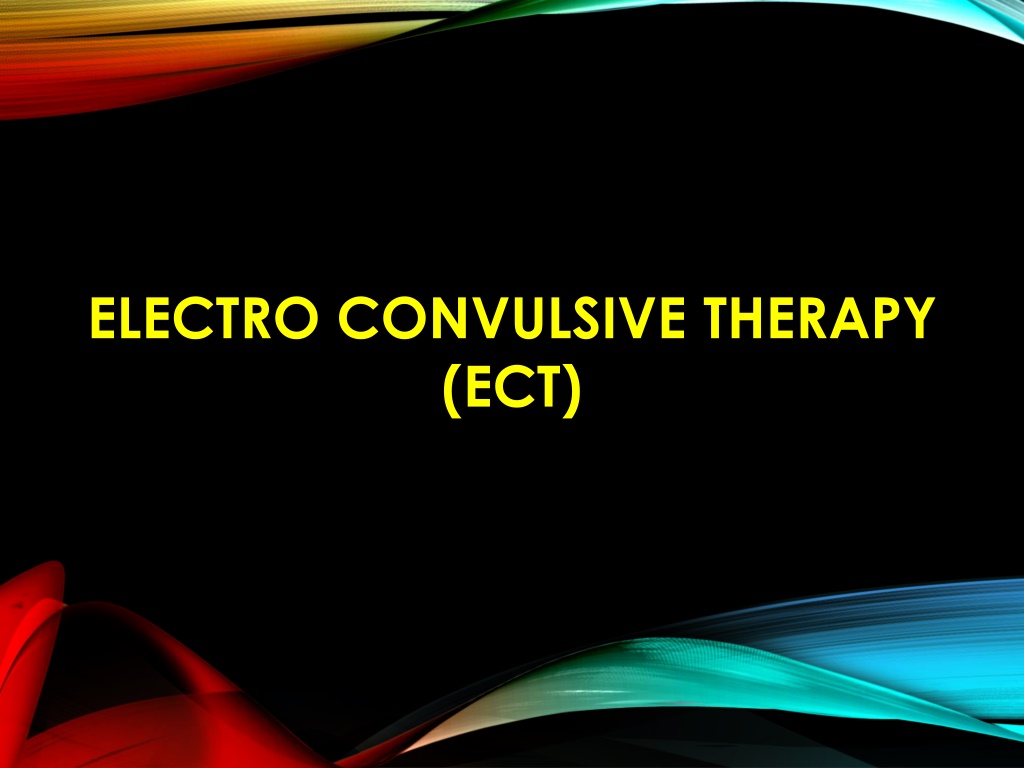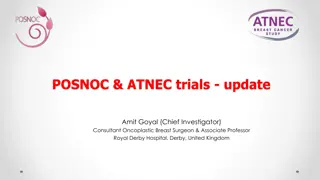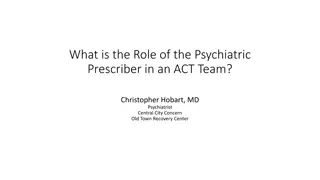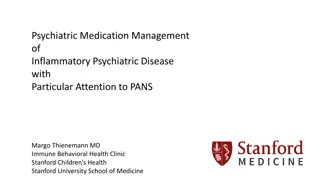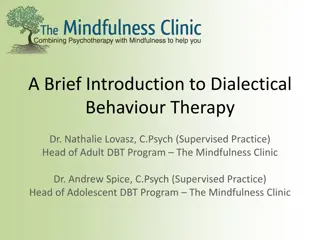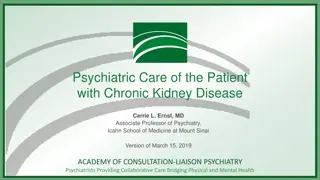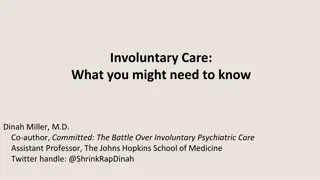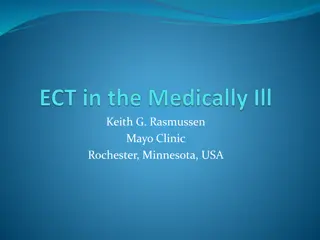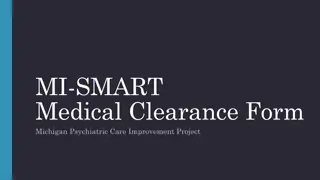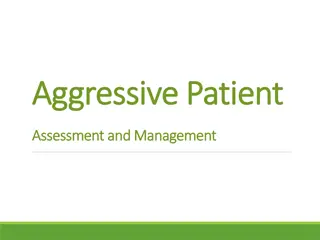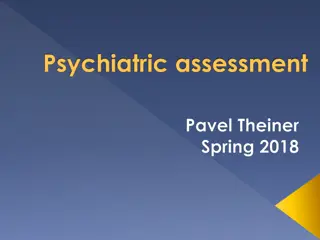Understanding Electroconvulsive Therapy (ECT) for Psychiatric Treatment
Electroconvulsive Therapy (ECT), also known as electroshock, is a psychiatric treatment that induces seizures in anesthetized patients for therapeutic purposes. ECT has a controversial history but is well-established in the medical field. Introduced in 1938, ECT has replaced older treatments like insulin coma therapy and pharmaco-convulsive therapy. The therapy involves the artificial induction of seizures by applying electrical current to the brain through electrodes. ECT's mechanism of action involves theories related to neurotransmitters, anti-convulsants, neuroendocrine functions, and brain damage. It is used to treat conditions like severe depression, bipolar disorder, and schizophrenia.
Download Presentation

Please find below an Image/Link to download the presentation.
The content on the website is provided AS IS for your information and personal use only. It may not be sold, licensed, or shared on other websites without obtaining consent from the author. Download presentation by click this link. If you encounter any issues during the download, it is possible that the publisher has removed the file from their server.
E N D
Presentation Transcript
Electroconvulsive therapy (ECT), also known as electroshock, is a well established, although controversial psychiatric treatment in which seizures are electrically induced in anesthetized patients for therapeutic effect
ECT was first introduced by Italian psychiatrist Ugo Cerletti and Lucio Bini in April 1938 Insulin coma therapy and pharmaco-convulsive therapy were replaced by ECT Insulin coma therapy was introduced by the German psychiatrist Manfred Sakel in 1933 Pharmaco-convulsive therapy was introduced in Budapest in 1934 by Ladislas Meduna In 1974, the APA s council on research and development appointed a task force on ECT The APA task force on ECT, in 1976, gave its report which provided clear guidelines for use of ECT
DEFINITION Artificial induction of a grand mal seizure (a loss of consciousness and violent muscle contractions) through the application of electrical current to the brain, the stimulus is applied through electrodes which are placed either bilaterally in the fronto-temporal region or unilaterally on the non dominant side. ECT is a physical/somatic therapy in which the help of two electrodes, current is passed through the temporal region in between the two hemispheres of the brain, to produce a grand mal type of seizure. PARAMETERS Voltage- 70-120 Volts Duration- 0.7-1 .5 sec
MECHANISM OF ACTION Neuro-transmitter theory Neuro-endocrine theory Anti-convulsant theory Brain damage theory Psychological theory
Neurotransmitter theory: ECT works like anti-depressant medication, changing the way brain receptors receive important mood-related chemicals. Anti-convulsant theory: ECT-induced seizures teach the brain to resist seizures. This effort to inhibit seizures dampens abnormally active brain circuits, establishing mood.
Neuroendocrine theory The seizure causes the hypothalamus to release chemicals that cause changes throughout the body. The seizure may release a neuropeptide that regulates mood. Brain damage theory Shock damages the brain, causing memory loss and disorientation that creates an illusion that problems are gone, and euphoria, which is a frequently observed result of brain injury (Both are temporary)
Psychological theory Depressed people often feel guilty, and ECT satisfies their need for punishment. Alternatively, the dramatic nature of ECT and the nursing care afterwards makes patients feel they are being taken seriously the placebo effect
BENEFITS OF ECT: ECT relieves very severe depressive illnesses when other treatments have failed. ECT has saved patients' lives because 15% of people with severe depression will kill themselves. ECT works faster than all antidepressants drugs. Types of ECT Direct ECT Modified ECT Unilateral ECT Bilateral ECT
ELECTRODE PLACEMENT Bilateral (BL) - most common, most effective, most cognitive dysfunction Right unilateral (RUL) - less cognitive effect, may be less clinically effective
Modern ECT Electrode s are placed on the side of a patient s head just above the temples. The patient is given anesthetic injections and a muscle relaxant to stop muscle contractions that can lead to broken bones. A small electric current is passed through the brain.
INDICATIONS Severe depression Severe episodes Need for rapid antidepressant response (e.g. due to failure to eat or drink in depressive stupor; high suicide risk) Failure of drug treatments Patients who are unable to tolerate side- effects of drug treatment (e.g. puerperal depressive disorder)
Previous history of good response to ECT Patient preference Suicidal ideas Mania, that hasn t improved with medications Severe Catatonia Schizophrenia Psychosis, when medications are insufficient or symptoms are severe All of the above disorders during pregnancy.
CONTRA-INDICATIONS Absolute Increased ICP (intracranial pressure) Relative Cardiovascular (Coronary artery disease, HTN, aneurysms, arrhythmias) Cerebrovascular effects (Recent strokes, space occupying lesions, aneurysms) Severe pulmonary diseases (T.B, Pneumonia, Asthma)
COURSE OF ECT ECT is usually given 3 times a week, reduced to twice a week or once a week once symptoms begin to respond. This limits cognitive problems. There is no evidence that a greater frequency enhance treatment response. Treatment of depression usually consists of 6-12 treatments. Treatment-resistant psychosis and mania up to (or sometimes more than) 20 treatments. Catatonia usually resolves in 3-5 treatments.
Before beginning a series of ECT treatments, a patient should receive a thorough psychiatric assessment, including a medical examination and sometimes a basic blood test and an electrocardiogram (ECG) to check heart health. Informed consent: A patient must provide written informed consent before ECT is administered. In situations where a person is too ill to make decisions for him or herself, the consent process is governed by state law (for example, a court- appointed guardian).
Patients and their families should discuss all options for treatment with the psychiatrist before making a specific treatment decision They should be provided with sufficient information to fully understand the procedure and the potential benefits, risks, and side effects of each treatment option before providing written consent
